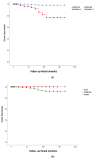Increasing Importance of Genotype-Phenotype Correlations Associated with Common and Rare MEFV Gene Mutations in FMF Patients in the Last Thirty Years
- PMID: 39941383
- PMCID: PMC11818418
- DOI: 10.3390/jcm14030712
Increasing Importance of Genotype-Phenotype Correlations Associated with Common and Rare MEFV Gene Mutations in FMF Patients in the Last Thirty Years
Abstract
Background/Objectives: Studies have shown that some mutations, especially M694V, are correlated with renal RI and/or AA. There are limited data about rare mutations on severity of the disease and RI. Today, evaluating genotype-phenotype correlations in rare mutations is important to better understand FMF. We aimed to evaluate clinical, demographic and genetic changes and genotype-phenotype correlations in pediatric patients with FMF over thirty years as well as the importance of the rare mutations. Methods: A total of 2765 pediatric patients with FMF were included in this study. Genetic results were firstly divided into ten groups including rare mutations. Rare mutations were seen in 2% of all patients and divided into eight groups. Results: There was a significant increase in compound heterozygous mutations, E148Q het/hom, R202Q het/hom, complex mutations and rare mutations in the last decade. RI wo AA was 5.8% and AA was 1% in the patients with rare mutations. While M694V and compound het with M694V were positively correlated with severe PRAS, E148Q and V726A were negatively correlated with severe PRAS (p < 0.05, R = 0.137, R = -0.077, R= -0.05, respectively). Although K695R mutation was negatively correlated with severe PRAS (p < 0.05, R = -0.04), the rate of RI was 20%. Although the rare mutation R761H was negatively correlated with severe PRAS (p < 0.05, R = -0.051), the colchicine resistance rate was 8.3%. Conclusions: It may be misleading for clinicians that mutations which have increased in frequency over the years are clinically mild. RI and AA rates in rare mutations are not less than the related rates in common mutations.
Keywords: Familial Mediterranean Fever; disease severity; genotype; phenotype; rare mutations.
Conflict of interest statement
The authors declare no conflicts of interest.
Figures
References
-
- Soriano A., Pras E. Familial mediterranean fever: Genetic update. Isr. Med. Assoc. J. 2014;16:274–276. - PubMed
-
- Twig G., Livneh A., Vivante A., Afek A., Shamiss A., Derazne E., Tzur D., Ben-Zvi I., Tirosh A., Barchana M., et al. Mortality risk factors associated with familial Mediterranean fever among a cohort of 1.25 million adolescents. Ann. Rheum. Dis. 2014;73:704–709. doi: 10.1136/annrheumdis-2012-202932. - DOI - PMC - PubMed
LinkOut - more resources
Full Text Sources



